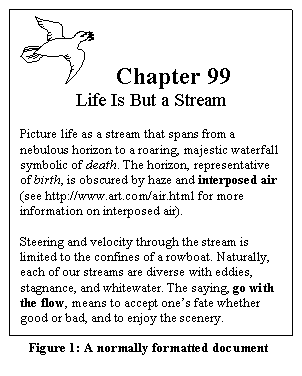 |
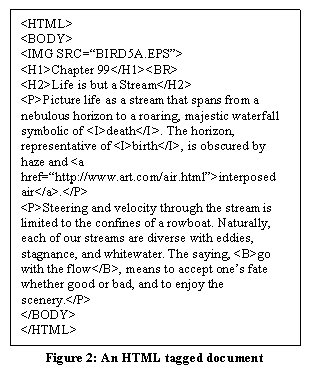 |
by Steven Aoki
March 15, 1999
GRC 461 (Senior Project)--Harvey Levenson
Cal Poly State University, San Luis Obispo
This study addresses XML (eXtensible Markup Language) which will likely become the
next international standard for the World Wide Web. The World Wide Web Consortium (W3C)
standardized XML 1.0 as an official recommendation on February 10, 1998. Its two
companions, XSL (eXtensible Stylesheet Language) and XLL (eXtensible Linking Language)
became working drafts on August 18, 1998 and March 3, 1998 respectively. So far, the two
primary World Wide Web browsers have announced support for XML. The Microsoft Corp.
included an XML parser and XSL renderer in Internet Explorer 4.0, and promises more
advanced XML tools such as expanded stylesheet support in Internet Explorer 5.0 (due at
the end of 1998). Netscape Communications Corp. reports advanced XML tools in its
Netscape Communicator 5.0 (due at the end of 1998). Also, Microsoft Office 2000 (due
at the beginning of 1999) and Adobe FrameMaker 5.5 will feature user friendly XML
utilities.
Languages written in XML to generate broad standardization have begun emerging
rapidly. Information and Content Exchange (ICE) will help syndicate data for multiple
uses on the Web, RDF (Resource Definition Format) will help Web sites describe themselves,
VML (Vector Markup Language) and PGML (Precision Graphics Markup Language) will address
vector graphics, SMIL (Synchronized Multimedia Integration Language) will link text,
audio, graphics and animations, VoxML (Voice Markup Language) from Motorola will
simplify voice-driven technology, CML (Chemical Markup Language) will classify chemical
elements, and MML (Mathematical Markup Language) will automate mathematic
typesetting.
Furthermore, XML has gained popularity in electronic commerce because of its focus on
structured information for data transaction. The Open Financial Exchange, supported by
Microsoft, banks, financial service companies, and software development firms, has begun
developing on-line financial standards based on integrating XML into the client and
server. Meanwhile, the Financial Services Technology Consortium began work on an XML
electronic commerce messaging format that will standardize check processing via the
Internet. Another consortium aimed at retail market, the Open Trading Protocol, proposed
an XML-based specification aimed at retail commerce on the Internet in an initiative
backed by MasterCard International, AT&T, Hewlett-Packard, IBM, and Wells
Fargo.
Between XML, HTML, and SGML, what will best suit Robert E. Kennedy Library? For now, I predict XML. HTML's rigid formatting options, lack of content description, constant updating, and perpetual differences between browsers make it both inflexible and unstable. SGML's complexity and small vendor markets make it both difficult and expensive to maintain. XML combines the best from both languages by combining the simplicity of HTML with the flexibility SGML.
The purpose of this study is to prepare the Kennedy Library for an XML future by designing an experimental XML database for them. Currently, the library Gopher server houses various unsorted new book listings. I plan to tag these listings in XML and create an XSL stylesheet to automatically organize and display them on the World Wide Web. Since Web browsers under version 5.0 do not process XML, I will create a way to output the listings as HTML until versions 5.0 and above become standard.
To design a World Wide Web page, a designer or tool labels text pieces with HTML "tags" that tell a Web browser how to format the elements in the document. For example, to create a page like Figure 1, the HTML coding would need to look something like Figure 2:
 |
 |
The goal of XML resembles SGML's: to label the contents in a document by name rather
than appearance (see Figure 3) 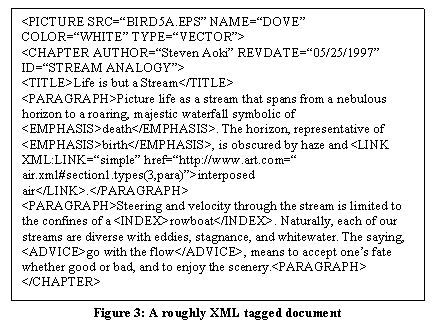 , so that
the document can output as any proprietary medium imaginable, e.g., books, CD-ROM, World
Wide Web page. Thus, documents only need to be edited one time--at the source--and then
output on-demand through automated conversion. Furthermore, the same XML document can be
programmed to revise itself based on who the audience is. For example, a publisher can
output an XML document as an American article and as a translated German CD-ROM, complete
with altered cultural references and monetary units. Because of XML's flexibility with
changing audiences, it especially lends itself to advanced forms of personalization and
variable printing.
, so that
the document can output as any proprietary medium imaginable, e.g., books, CD-ROM, World
Wide Web page. Thus, documents only need to be edited one time--at the source--and then
output on-demand through automated conversion. Furthermore, the same XML document can be
programmed to revise itself based on who the audience is. For example, a publisher can
output an XML document as an American article and as a translated German CD-ROM, complete
with altered cultural references and monetary units. Because of XML's flexibility with
changing audiences, it especially lends itself to advanced forms of personalization and
variable printing.
XML vs. HTML
XML expands on HTML in many ways. First, XML's tags resemble fields in a database,
allowing industries to customize their own database managing systems. One application
is efficient online commerce. For example, a paper vendor could use special tags like
basic size, color, and price for a database form--then automatically output those
descriptions as a paper catalog or Web page. Another application is database publishing.
David L. Zwang from American Printer explains that society's increasing
on-demand mentality has caused product and service providers to demand immediate paper
and Web publication. Instead of hiring a large staff to coordinate constant revision of
both paper and Web documents, Zwang recommends a better solution by editing one source
document and automatically outputting its respective versions through XML. He concludes
that printers should begin moving toward XML by logically identifying recurring elements
in customer jobs .
Second, because HTML limits World Wide Web pages to rigid page-oriented instructions,
designers can not control fundamental formatting like precise white spacing, kerning,
hyphenation, hanging indents, and column
snaking.
Third, HTML suffers from instability. Aside from forcing designers to keep up with
evolving versions, i.e., HTML, HTML+, HTML 2, HTML 3, and HTML 4, browsers provide
proprietary HTML extensions like "blink" and "center" tags that do not work between
browsers.
Fourth, since HTML describes page layout rather than content, users can only search
Web pages for key words. This tends to flood users with unrelated results. For example,
a search for information on the "Baltimore Orioles" baseball team would probably highlight
various pages about the Maryland state bird as
well.
Finally, hyperlinks in basic HTML only offer two options: sending the user to an
entirely different document or sending the user to a pre-defined line in any document.
XLL (eXtensible Linking Language) would allow designers to greater customize their own
hyperlink actions in XML documents. For example, clicking on a hyperlinked word could
send the user to anywhere in another document or display a certain portion of text from
another document. Or, the designer can specify multiple hyperlink destinations and set
criteria for which one to go to, e.g., a hyperlink could send a user to introductory or
advanced software documentation depending on that user's level of
expertise.
The World Wide Web Consortium deemed XML as the next generation of HTML (instead of
HTML 5.0).
XML vs. SGML
XML sprung from SGML, an international standard (ISO 8879:1986) that used the exact
same concepts of intelligent tagging. SGML served certain high-end publishing niches
such as aircraft maintenance manuals and federal government reports.
Publishers and Web designers created XML by stripping down SGML for the less
technically literate. While the SGML specification features nearly 300 pages, XML's
specification takes about a tenth of that.
Given XML's momentum, I conclude that it has the potential to dominate over HTML and SGML as long as industries accept it as the ideal strategy for complex data management, publishing, and online commerce. I predict this "revolution" will begin at the end of 1998 when XML document and stylesheet authoring becomes more user friendly.
I programmed an XML database for the Robert E. Kennedy Library. I will graduate in March 1999 and would like to simplify operations for my successor in Kennedy Library's multimedia department. Currently, the library maintains a listing of new books at gopher://gothic.lib.calpoly.edu:70/11/CalLib_Info/Book_List/. The web page classifies each book in the following subdirectories: Cal Poly major and then month published. Each book listing requires the following recurring information: title, author, subject, publisher, publishing date, major, and call number. As the system stands, I must manually input these fields into an HTML page. I plan to "tag" the fields with XML to simplify operations for myself and the "successor" who will take over my job when I graduate.
I used descriptive research to describe "what exists." Under the hypothesis that XML is easier to use than HTML, I tagged each book by XML and HTML. XML uses conceptual tags like "title" and "author" while HTML uses formatting tags like "bold" and "paragraph space." Using a stopwatch, I measured the time it takes to construct XML and HTML documents that follow library specifications. My table compares time with number of book listings, i.e., the time for one, ten, twenty, and thirty books per listing. I also needed a row for initial start-up time since the XML document requires an XSL stylesheet. Along the way, I noted any complications I encountered from the XML/XSL system.
I expected that start-up time for an XML document to take longer than start-up for an HTML document, since an HTML document requires little preparation. However, in the long-run I expected XML's automatic formatting to overtake manual HTML design in speed.
My supervisor at the Kennedy Library did not allow me to download Microsoft Internet Explorer 5.0 Beta due to her fears of its instability. Since only Internet Explorer 5.0 and Netscape Communicator 5.0 will accept pure XML, I had to convert all my XML files into HTML files via XSL stylesheets to accommodate the current browsers. Internet Explorer 5.0 and Netscape Communicator 5.0 will come out in the near future.
To convert the XML to HTML via XSL, I downloaded IBM's LotusXSL converter from http://www.alphaWorks.ibm.com/formula/lotusxsl on February 8, 1999 and an XML parser from http://www.alphaWorks.ibm.com/formula/XML on February 9, 1999.The converter and parser only work in Java, so I also downloaded Sun Microsystems' "Java Development Kit" from http://www.javasoft.comm/products/jdk to run it. These all require MS-DOS to work. I installed them into the hard drive of my 233 MHz Pentium PC in the multimedia department. I typed the XML-tagged books through "notepad" in Windows 98.
I used Microsoft FrontPage Editor 98, Kennedy Library's World Wide Web editor of choice, for the HTML side of the experiment. I suspect that my average typing speed (60 words per minute) and mastery of FrontPage Editor slightly skewed the results.
In preparing my experiment to prove the ease of XML, I encountered various complications. My first problem originated on December 16, 1998 when the World Wide Web Consortium (WC3) completely revised its XSL 1.0 working draft from the August 18, 1998 version. XML utilities changed to accommodate the new draft, ultimately resetting my learning curve and making my XML reference books obsolete. This caused me to develop serious reservations about the stability of XML's companion language, XSL. It also cost me a week to learn the new specifications.
Second, upon downloading the new XML utilities, I had difficulties linking the XML converter and XML parser together. Eventually, I sorted out the directories and connected the two utilities by using the MS-DOS command prompt to type "set classpath=c:\lotusxsl\xml4j\xml4j_1_1_14.jar;c:\xml\lotusxsl\lotusxsl\lotusxsl.zip" and then running the program by typing "java com.lotus.xsl.xml4j.ProcessXSL -in test.xml -xsl test.xsl -out test.html"--not the user-friendliness I had hoped for. I lost two days to solve this problem.
Finally, simple typos in the XML and XSL versions disrupted the entire process. I had to consume more time fixing such bugs. Eventually, I refined an XSL stylesheet and XML test file for new books at the library (see Figures 4 and 5).
 |
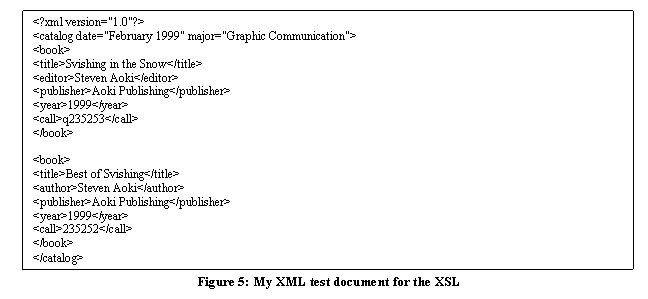 |
Table 1 illustrates the results of the timed HTML and XML/XSL
comparisons. 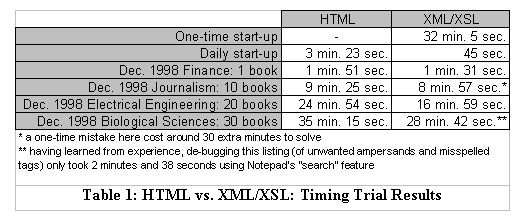 I dedicated February 19, 1999
and February 25, 1999 to gather data. On February 19, I tagged the December 1998 book
listings for finance, journalism, and electrical engineering in both HTML and XML (see
Table 1, Appendices A and B). On February 25, I tagged the December 1998 biological
science listings in both HTML and XML (see Table 1, Appendices A and B). I chose
these particular book listings because of their coincidental book quantities.
I dedicated February 19, 1999
and February 25, 1999 to gather data. On February 19, I tagged the December 1998 book
listings for finance, journalism, and electrical engineering in both HTML and XML (see
Table 1, Appendices A and B). On February 25, I tagged the December 1998 biological
science listings in both HTML and XML (see Table 1, Appendices A and B). I chose
these particular book listings because of their coincidental book quantities.
These results do not reflect the time I would spend in real-life for proofreading. As stated before, my mastery of FrontPage Editor made the HTML results a little faster than normal. Also, my average typing speed (60 words per minute) made both columns a little faster than the normal typist. Times may have slowed down for the biological science listings for two reasons: fatigue from tediously typing in 30 books without a break, and long biological science jargon that I had trouble typing.
I do not recommend using XML for Kennedy Library's "new book" catalog until Microsoft Internet Explorer 5.0 or Netscape Communicator 5.0 become widely accepted. Converting XML to HTML via XSL only seems to complicate basic HTML inputting, and currently defeats my hypothesis that XML is easier to use than HTML.
First, the XML results demonstrated a negligible time advantage over HTML. Simply put, FrontPage Editor's "cut and paste" feature speeds up efficiency that rivals XML's easy tagging.
Second, I found XML's sensitivity to errors frustrating. HTML is much more tolerant to typographic or logic errors. If an XML page has a single error, the parser will display cryptic error messages instead of the flawed page. Debugging the ten-book catalog consumed an extra half-hour of my time on a page that should've taken less than ten minutes to construct. Since I and my successor will inevitably err, XML will no doubt compound our stress.
Third, I suspect instability in XML's companion, XSL. Within roughly four months, the specifications for the language had completely changed. It means the library would have to generate a new XSL stylesheet to keep up with the new changes.
In conclusion, I predict HTML will continue to dominate for some time--at least until Microsoft Internet Explorer 5.0 or Netscape Communicator 5.0 become widely accepted. My project will help prepare the Kennedy Library for the upcoming benefits of XML, including searches by title, author, publisher, year, call number instead of just keyword; and increased compatibility with different applications. But for now, XML's meager support and difficult HTML conversion will only complicate workflow at the Kennedy Library.
[ BACK TO PROJECTS ]